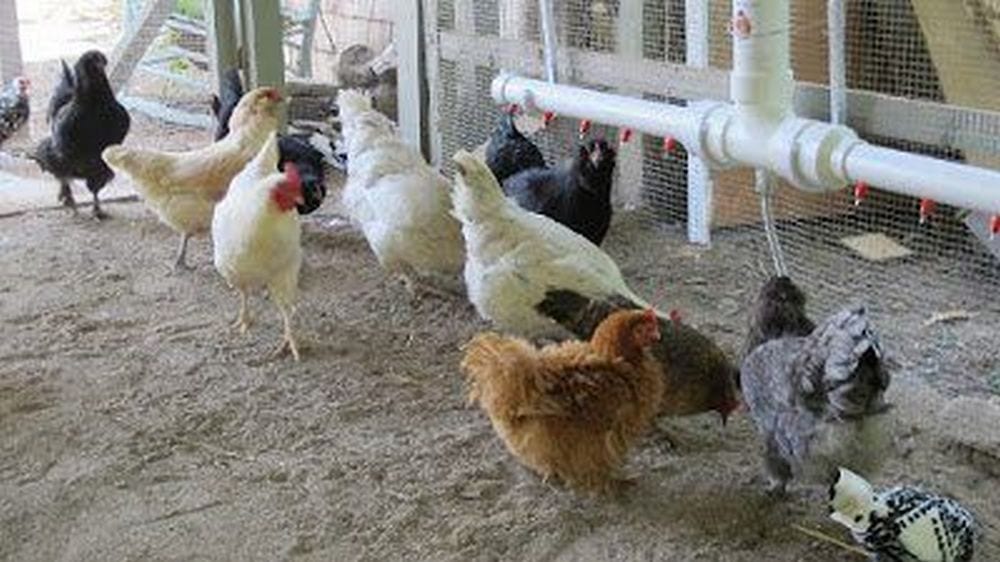Is your chicken coop in need of a little TLC? Have you been looking for an affordable and convenient way to keep your hens hydrated? Then you’re in the right place.
You’ll learn all about automatic chicken waterers — what they are, how to use them, and why they’re the perfect solution for any chicken owner!
Automatic chicken waterers provide convenient, hassle-free access to fresh water for chickens. They allow chickens to drink without having to access a shallow water dish and are designed to hold a larger supply of water than what is available through traditional open containers. Automatic chicken waterers are an efficient way to provide poultry with ample amounts of clean, fresh drinking water while reducing the amount of time you need to spend providing refills and cleaning their dishes.
With the ever-growing popularity of backyard chickens, automatic chicken waterers have become increasingly commonplace among flocks both large and small. Easily installed and filled, these devices can provide your birds with a steady source of fresh water for weeks at a time. After installation some devices do not require any further setup or maintenance; others may need occasional cleaning or refilling as necessary.
With automatic chicken waterers, chickens never run low on clean drinking water as these devices reduce the chances of contamination from fallen food or droppings and keep their water clean for extended periods of time.
Explanation of Automatic Chicken Waterers
Automatic chicken waterers provide a convenient way to keep poultry watered. These devices are designed with several components to ensure a clean, ready supply of water is always accessible for chickens. An automatic waterer may include a tank, a drinking area, an inlet regulator and a filter. Automatic chicken waterers are easy to install and maintain, saving owners time and ensuring chickens always have clean, fresh water available.
The tank is usually either plastic or metal and generally holds 15-20 gallons of water. The bottom of the tank has an inlet regulated opening so that excess water drains back into the main container when it gets too low. This helps to avoid over-filling and unnecessary waste. Most tanks also come with an overflow valve that prevents flooding if too much water is added at once.
The drinking area typically consists of multiple nipples located in different parts of the waterer throughout the container’s interior circumference — this makes sure that no matter where chickens drink from, they will always have access to fresh water. The nipples are leak-proof and adjustable so that you can customize how much water is released with each sip your birds take.
To make sure your birds’ drinking area remains clean and free from bacteria, most automatic chicken waterers come equipped with a built-in filter system that removes contaminants from the tank before every refill cycle — making sure only clean, healthy water ends up in your coop! Most filters need regular cleaning or replacement depending on the type you choose (e g., sponge or charcoal).
By investing in an automatic chicken waterer you can provide your flock with convenient access to fresh clean drinking water – all while relieving yourself of the hassle associated with manually filling multiple individual containers!

Advantages of Using Automatic Chicken Waterers
Automatic chicken waterers come with several advantages for the poultry keeper. The biggest benefit of using an automatic waterer is that it maximizes efficiency. This waterer continuously refills, providing your chickens with plenty of fresh water throughout the day. This system also helps minimize water waste, as it does not use as much water as manual systems (i.e., cups or bowls). Additionally, many models are designed to reduce spills and leaks, making cleanup easier and eliminating potential messes around your coop.
Moreover, these systems can help cut down on the time involved in maintaining your chickens’ health and wellbeing. With an automatic system, you won’t need to take time each day to fill individual cups or large containers with clean water — letting you spend more time enjoying your chickens and less time caring for them!
Finally, automatic chicken waterers provide an excellent way to keep predators away from your birds. Many predator-proof models are available on the market and these can give you peace of mind knowing that pests cannot get access to the birds’ drinking water supply. They also reduce contamination risks caused by other animals or dirt getting into the waterers — something which is especially important if you have organic poultry.
Importance of Chicken Waterers
In order to ensure healthy, productive chickens, it is essential to make sure they always have access to plenty of clean, fresh water. Unlike other animals, chickens cannot survive without this vital resource. It helps maintain their overall health and provides the hydration needed for a variety of bodily functions such as digestion and regulation of body temperature. Water also plays a role in aiding the growth and development of young birds and helps adult chickens produce eggs when they are laying.
For those who keep chickens at home either as pets or sources of food or income, providing water can be time consuming. Automatic chicken waterers can help make this task easier by providing a steady source of clean water that does not require daily refilling or cleaning like traditional waterers do. These devices come in both ground-level and hanging models that free up time for other tasks such as tending to the flock’s feed supply or addressing any inclement weather conditions outside.
An automatic chicken waterer runs on electricity but uses very little power and is designed to minimize lost water so there is no need for daily refills throughout the day and night thanks to their large-capacity tanks and filtering systems. In addition, since these units do not suffer from algal growths due to infrequent refills, chicken owners will be able to reduce their workload while ensuring their birds remain hydrated at all times.
Factors to Consider When Choosing an Automatic Chicken Waterer
When considering an automatic chicken waterer, there are many factors to consider that will help you choose the right product for your flock. Cost is an important factor, as high-quality products often cost more. However, a quality waterer will last for years and is usually worth the investment.
Next, you’ll want to consider the size and type of unit you need. For small flocks, a plastic or nipple-style unit may be sufficient but larger flocks may require something more substantial like a galvanized steel tank or reservoir. These tend to be on the pricier side, but they require minimal maintenance and can provide fresh water for large numbers of birds for many years.
Finally, it’s important to think about how often you will need to clean and refill your waterer. Many automatic models come with filters that need to be changed regularly in order to maintain clean water supply. If you plan on having frequent visitors in your yard or pasture, it is also a good idea to equip your chickens with access to safe drinking water during these times as well. Automatic chicken waterers can also give birds access to clean cold water during hot summer months when traditional pails quickly heat up in direct sunlight.
Waterer Size
When it comes to automatic chicken waterers, size matters. Choosing the right size waterer is important because it ensures that your chickens always have enough clean water available. The most common sizes of automatic chicken waterers are 1 gallon, 2-3 gallons, 4-5 gallons, and 10 gallons and larger.
1 gallon waterers are the smallest size and can typically hold just one day’s worth of water for a small flock of chickens (up to 8 birds). 2-3 gallon automatic chicken waterers are ideal for flocks of up to 10 birds and will provide enough water for about two days before needing a refill. 4-5 gallon waterers are perfect for larger flocks (up to 20 chickens) that require more than just one day’s worth of water.
Last but not least, 10 gallon and larger sizes are great for very large flocks or if you plan on being away from home for more than two days at a time; they can usually provide enough water supply without needing to be refilled more than once per week.
Chicken Size
The size of your flock will determine the type of waterers you need to purchase. It is important to consider the container size and the number of chickens you plan to house. Smaller flocks (less than 10 birds) will require a smaller container capacity, while larger flocks may need a larger container capacity. Additionally, some automated systems come with multiple water tanks that hold different capacities. The number of chickens per tank should be clearly listed on any product package or website listing.
The height of the waterer is also important to consider when purchasing an automatic chicken waterer for your flock. Small hens can comfortably drink from a fount that stands 11-14 inches off the ground, while larger chickens may require a tall waterer that stands up to 18 inches in height. Height can also affect other factors such as setting up in your brooder box or enclosure and that’s where adjustable models can come in handy as they provide an extra few inches of adjustment for different ages and sizes in your flock.

Waterer Material
When it comes to material for your chicken waterer, there are three main types — plastic, metal, and ceramic. Plastic is lightweight and generally the least expensive option. However, because of its porous nature it can harbour bacteria and algae growth if not cleaned regularly. Metal waterers tend to last longer than plastic and can be easily cleaned with vinegar or other acidic solutions. Ceramic waterers are of similar quality to metal but may require a bit more maintenance as they can chip or crack over time.
When selecting a material for your automatic chicken waterer, consider how much time you want to dedicate to upkeep and also how much you’re willing to spend. Plastic is likely the most convenient option as it’s inexpensive and light-weight but may require more hands-on cleaning than metal or ceramic counterparts over the long run. Metal tends to last longer but may need acidic solutions like vinegar or baking soda for deep cleaning on occasion. Finally, ceramic might be the most eye-catching option but requires extra attention in terms of handling and cleaning due to its fragility.
Waterer Cost
For those wishing to purchase an automatic waterer, cost is an important factor. Automatic waterers are available in a range of prices, with more expensive models often providing advanced features such as built-in filtration and water sensors. Basic automatic waterers will typically range from $50 – $120, but can cost even more if you need a specific size for your chickens.
Keep in mind that although these products may be more expensive upfront, they can help save money over time, since they reduce water waste and require less frequent refills than traditional troughs. In addition, some advanced models feature built-in timers or rain sensors that automatically shut off the water supply when not in use.
Ultimately, the cost of an automatic waterer should depend on your own level of need and preference. We recommend setting a budget and researching reputable brands to ensure you get the right product for your flock at a reasonable price!
Maintenance Tips for Automatic Chicken Waterers
Maintaining your chicken waterer is just as important as installing it correctly. Regular upkeep and cleaning can help to keep your hen hydrated, healthy and safe from contaminants. Here are a few tips on how to properly maintain an automatic chicken waterer:
-Replace the water at least once a week. Dirty water can quickly accumulate bacteria which can cause health issues for your birds. Replace the bowl or container weekly and make sure to clean any buildup of dirt or debris on the inside surfaces.
-Clean the bowl often. Use a mild soap solution and soft brush or cloth to clean the edges of the bowl, tube and nozzle periodically. Pay special attention to hard-to-reach areas like underneath the float within the tube to ensure all components are thoroughly cleaned.
-Check for leaks or loose parts every month. Make sure all fittings are secure, there is no leaking around them, and that all parts move freely without obstruction or sticking points in their normal cycle of operation (that means checking sometimes when the chicken is drinking). If anything appears amiss, replace it immediately.
-Inspect seals regularly. Bad seals between flexible tubing can allow contaminations into your waterer that could make your flock sick if consumed over time, so check them at least once a month for signs of wear or leakage at both ends of all tubs involved with making up each part of your system(Tubing from drinking cups/valves). Replace any faulty seals promptly to keep your flock safe from harm’s way!
Regular Cleaning
Regular cleaning of the automatic chicken waterer is essential for maintaining its efficiency and preventing the growth of bacteria. Any dirt or debris that accumulates can block the water flow, potentially resulting in poor water quality or poor sanitation for the poultry. Most waterers come with an easy-to-clean design but must be regularly checked and serviced to ensure optimal performance. To keep your chickens safe from diseases, it is best to clean their drinking system at least weekly and after any major event such as storms, floods or heavy rain. Here’s a step-by-step guide to cleaning your automatic waterer.
- Take out the removable components: Before you start to clean your waterer, be sure to remove all removable parts such as buckets, nipples and valves that are not built into the body of the system.
- Clean inside parts: Using hot water and your favorite dish soap, thoroughly scrub all internal components such as screens, pipes and connectors until they are free of dirt, debris and other contaminants. Be sure to dry all components completely after washing so as not to encourage mold growth in wet areas.
- Sanitize: Use a safe chemical sanitizer on all internal and external elements of your unit before reassembling it for use again. This will ensure that no harmful bacteria or viruses remain within the system that could be passed on to your birds through their drinking water source.
- Rinse: Finally, give everything a good rinse with fresh running water prior to reassembly so that any residual soap suds do not contaminate the pooling water when you refill it for your birds’ consumption.
Winterizing the Waterer
When winter approaches, it’s important to take the necessary steps to protect your chickens’ automatic waterer from freezing temperatures. A frozen waterer can prevent your chickens from drinking, leading to dehydration and possible death. To winterize an automatic waterer:
- Disconnect the water line and remove the lid to inspect the rubber grommets inside of the lid which ensure a water-tight seal. If these are worn down or damaged, replace them before reconnecting the water line and replacing the lid.
- Fill up the reservoir with a glycerin or engine block antifreeze solution, mixed in a s 1:4 ratio with distilled water (1 part antifreeze, 4 parts water).
- Remove any excess ice or buildup inside of both buckets, if necessary.
- Reconnect the water line back onto the valve and lid assembly, making sure it is securely in place and no leakage is seen when full of fluid solution
- Refill every other day throughout winter months and maintain at least 2″ of liquid so prevent freeze ups.
Inspecting for Wear and Tear
When it comes to inspecting your automatic chicken waterer, it’s important that you check for any signs of wear and tear. To do this, you must check all of the key components. These include the reservoir, valve bodies, valves and float ball and control mechanisms. Make sure nothing looks out of place or appears to be damaged or worn down.
It’s also a good idea to clean any dirt or debris away from the machine and make sure all the pieces are functioning properly. If anything looks out of order, consult your manual for troubleshooting advice or contact an expert for help. Additionally, replacing parts may be necessary if damage is severe enough.
Regular Waterer Checks
In order to ensure that your automatic chicken waterer is functioning properly, it is important to perform regular maintenance checks. Practicing regular maintenance can help avoid issues such as clogged lines and wet substrate in the bottom of the waterer. Proper maintenance also helps to extend the life of your automatic chicken waterer and ensure clean drinking water for your chickens.
To begin, start with an inspection of the exterior. Check all cables and connections for wear-and-tear or loose fittings which could lead to leaking or malfunctioning. Inside the waterer, check for any blockages in water lines that could hinder water flow or result in standing water at the bottom. Clean all parts of the waterer – take care when using cleaning agents as many are not safe for animals – and regularly change out any filters you might have installed. Finally, inspect each line of tubing and make sure no leaks are present before reinstalling it all back together.
Regularly check your water line pressure too; if it’s too low, you might need a new pressure gauge or perhaps even a new pump altogether. Remember to store any spare fittings correctly so they can be reused when necessary. Finally, don’t forget to check the components inside of bell drinkers once every few months and ensure proper functionality before putting them back into use again!

Conclusion
In conclusion, automatic chicken waterers are a convenient, economical solution to ensure your chickens always have access to clean and fresh water. Whether an individual chicken keeper or part of a small-scale egg farm, these devices can save you time and money.
With the right setup and maintenance, automatic chicken waterers provide clean and hygienic water for your flock without manual intervention. With a variety of models available in various sizes, you will be able to find the one best suited for your needs. These devices can offer years of safe and dependable service if properly cared for.
FAQ
What is the importance of chicken waterer?
A chicken waterer is important because it provides clean and fresh water to chickens, which is essential for their health and well-being.
What is an automatic chicken waterer?
An automatic chicken waterer is a device that automatically dispenses water to chickens without the need for manual refilling.
What is the best water system for chickens?
The best water system for chickens is one that is clean, easily accessible, and provides a constant supply of fresh water. This can be achieved through the use of a chicken waterer or an automatic waterer.
How does an automatic chicken feeder work?
An automatic chicken feeder works by dispensing a predetermined amount of feed at set intervals, either through gravity or a motorized mechanism.
Do chicken waterers work?
Yes, chicken waterers work effectively in providing clean and fresh water to chickens.
How much water do chickens need per day?
Chickens need approximately 0.5 to 1 liter of water per day, depending on their size and the temperature of their environment.
What is the purpose of a waterer?
The purpose of a waterer is to provide a constant supply of clean and fresh water to animals, such as chickens, for their health and well-being.
How do automatic waterers work?
Automatic waterers work by using a float valve or pressure system to maintain a constant water level and dispense water as needed.
What is the use of automatic drinker for poultry?
The use of an automatic drinker for poultry provides a constant supply of clean and fresh water to chickens, which is essential for their health and well-being.
What are the advantages of chicken feeders?
The advantages of chicken feeders include reducing waste, preventing contamination, and providing a constant supply of feed to chickens.
See Also :
- Best feeder for ducks 2023
- Best gloves for farm work 2023
- Best goat feeder 2023
- Best hat for farming 2023
- Best heat lamp 2023


